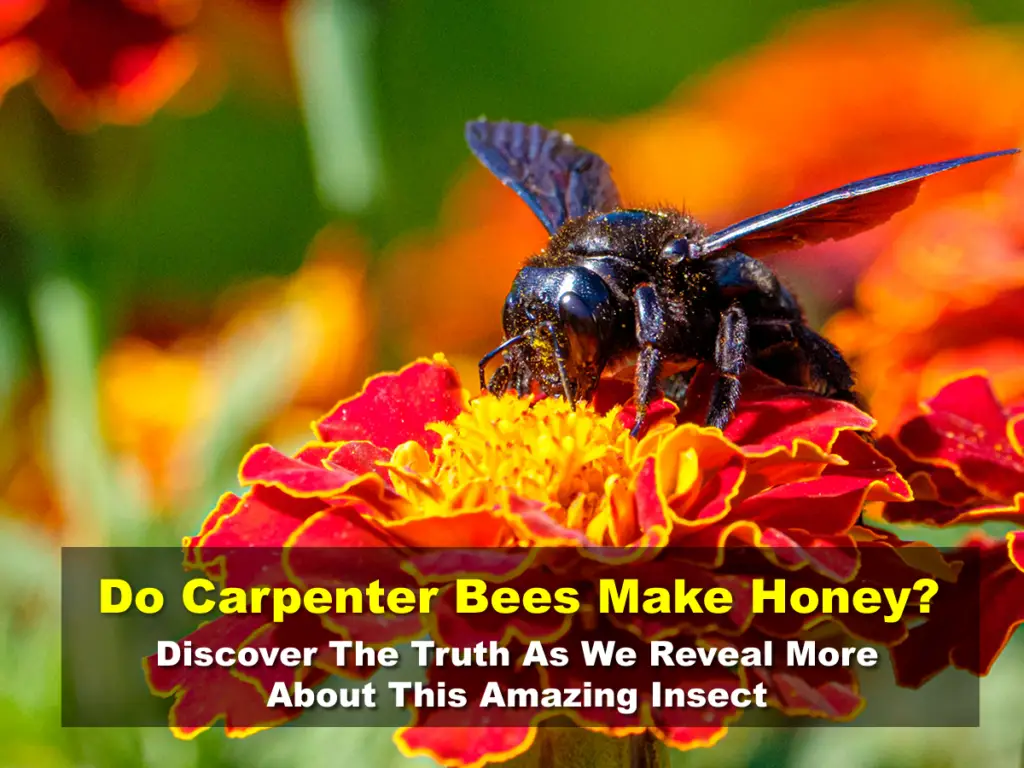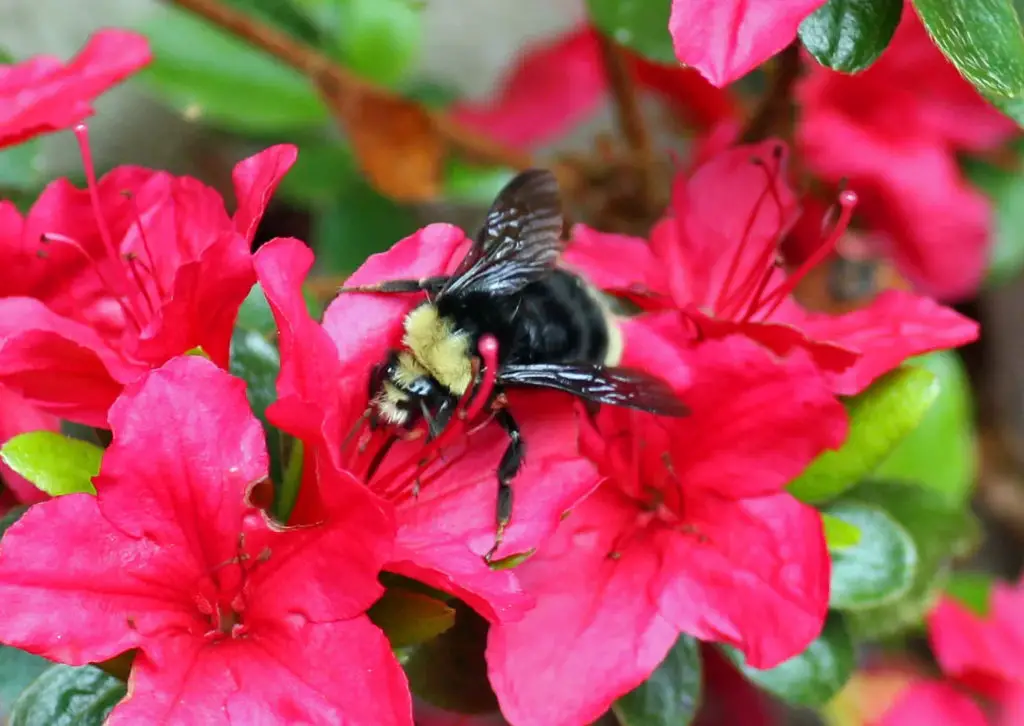Affiliate Disclaimer - As an Amazon Associate I earn from qualifying purchases.
It supports the website. So, Thank you
When you think about bees, one of the first things to enter your mind will likely be honey. But there are around 20,000 species of bees so it’ll probably come as no surprise to learn that they all have different traits, abilities, and behaviors.
The carpenter bee is a common species that most people recognize. But do carpenter bees make honey?
While carpenter bees are within the same family as honey bees, they’re not actually honey producers. But they are amazing in many other ways.
With that in mind, let’s take a closer look and get to know the carpenter bee a little better and learn about honey production within the bee kingdom.
Table of Contents
An Introduction To The Carpenter Bee
If you see a carpenter bee, you might mistake it for a bumblebee as the two species have a lot of similarities in terms of appearance. However, when you look a little more closely, you will notice that there are also key differences that allow us to tell the two apart.
For example, while bumblebees are hairy (they’re well-loved for their fuzzy appearance), carpenter bees are much smoother and shinier. What’s more, carpenter bees have much more uniform coloration with a black body while the bumblebee is famed for its striped appearance of yellow and black.
The carpenter bee is a solitary bee species that is only seen in larger numbers when it is nesting. Even then, there are usually only around 10 individuals in a nest with a higher number of males than females.
What sets the carpenter bee apart from other species is where it chooses to make its nest. As you can probably guess from its name, these bees like to nest in wood and they’re specially equipped to be able to bore into timber, making tunnels that lead to the nest. Once a nest is built, it’s not uncommon for carpenter bees to return the following year and start their reproductive cycle all over again in the same place.
The problem for humans is that, when carpenter bees nest in wooden structures, there is a risk of structural damage. They’re a common pest for homeowners in the United States and I’ve been asked countless times how to get rid of carpenter bees.
However, while they might be a nuisance, carpenter bees are important members of the ecosystem. What’s more, only the females possess a stinger and they’re not aggressive unless they are provoked.
Do Carpenter Bees Make Honey?
There are thought to be around 500 species of carpenter bees but none of them are known to produce honey. However, you’ll still see them buzzing from flower to flower as they collect nectar. This is one of the primary food sources for most bee species.
While honey bees turn nectar into honey to feed their young and sustain the colony over winter, this isn’t something that carpenter bees need to do. That’s because they’re a solitary species so having excess food stores simply isn’t necessary.
Of course, as these bees move between flowers, they also collect pollen so while they might not make honey, they’re still vital to the ecosystem and play an important role in plant reproduction.
Interestingly, they don’t gather pollen in the same way as honey bees. Where honey bees often have pollen baskets to which pollen sticks, carpenter bees knock pollen onto flowers in a phenomenon known as buzz pollination. This isn’t even something that honey bees are capable of doing.
Which Species Of Bees Make Honey?
When you think of honey-producing bees, you’ll likely imagine the common honey bee because that’s the most famous. However, there are other bees that are able to produce honey, even if it’s not on such a grand scale.
The Apidae Family
Apidae is the largest family of bees and contains more than 6000 different species, many of which are known for their honey-producing abilities. For this reason, a lot of bees within this family are known as honey bees.
Interestingly, the honey bee isn’t native to North America and pretty much every type of honey bee initially comes from Asia. Apart from one and that’s the European honey bee. These were brought to North America back in the 1700s and have since become naturalized. In fact, they’re considered one of the most beneficial insects on the continent.
Within the honey bee family, there are three subfamilies which include dwarf honey bees, cavity-nesting honey bees, and giant honey bees.
It’s the cavity-nesting honey bees that are popular with beekeepers who house the bees in purpose-built hives and harvest their honey for personal use or on a commercial scale.
Bees within the sub-dwarf family can often be found in shrubs and trees and while they can make honey, they don’t produce as much as the previous sub-family. Rather than storing honey within the large comb structure we see in a hive, the combs are much smaller and exposed to the air which isn’t the case with cavity-nesting bees.
Giant honey bees are usually found in locations like cliffs and will sometimes nest in buildings. They’re very common in southeast Asia and it was this species that caused ancient people to start harvesting honey in the first place.
If you’ve ever heard about the Spanish cave paintings from tens of thousands of years ago that depict the very first people harvesting honey then it was this species that was featured in these drawings. However, modern beekeepers don’t tend to use this species as it’s far more aggressive than others.
Bumblebees
The bumblebee is a common bee type from the family Bombus which is characterized by their large, rotund, hairy bodies. What’s interesting about bumblebees is that they can actually produce honey. Although, they make so little that they’d never be of significant use to humans.
All bees make honey for their young but while honey bees produce larger amounts because of their enormous colonies, bumblebees are more solitary so don’t need to produce as much. In a bumblebee nest, there are typically only between 50 and 250 bees and only one of these produces honey; the queen.
Queen bumblebees are the last to die and will nest in the fall and lay their eggs. However, it isn’t until spring that her young hatch, and just before this happens, she’ll start collecting nectar to make small amounts of honey to sustain them before she dies.
This honey is stored in wax thimbles which the queen secretes from her body and the molds into the correct shape. Once she has enough honey, the queen can remain in the nest with her brood and they’ll all have enough food to last until the weather gets warmer. However, the queen doesn’t usually survive for much longer as she only has a lifespan of 12 months. That said, there are some queen bumblebees that live to reproduce for a second season, although this is rare.
Stingless Bees
Earlier, I talked about the Apidae family and while most of these are honey bees, there are around 600 species within the family that are known as stingless bees.
These are largely tropical species and while they are able to produce honey, it’s never a lot which is why they’re not used in apiculture.
That said, some stingless bee species are managed by humans in a practice known as meliponiculture. This involves keeping the bees in a vertical hive where they will stack their brood combs with small pots of honey around the edges. However, while this was a traditional practice for many years, it’s something that isn’t as common today.
If you’re looking for a bee species that will produce just enough honey for your personal use then stingless bees might be of use to you. What’s more, any excess honey can be sold for a generous profit but again, I have to reiterate that the probability of the bees producing this much would be low compared to honey bees.
Final Thoughts
Carpenter bees are a familiar sight in many parts of the world and they’re known for their unique behavior of burrowing into wood to nest. But what a lot of people want to know is do carpenter bees make honey?
Not all species of bees are capable of producing honey and the carpenter bee is one of them. While it does collect nectar for food, it doesn’t turn this into honey using a process like honey bees.




